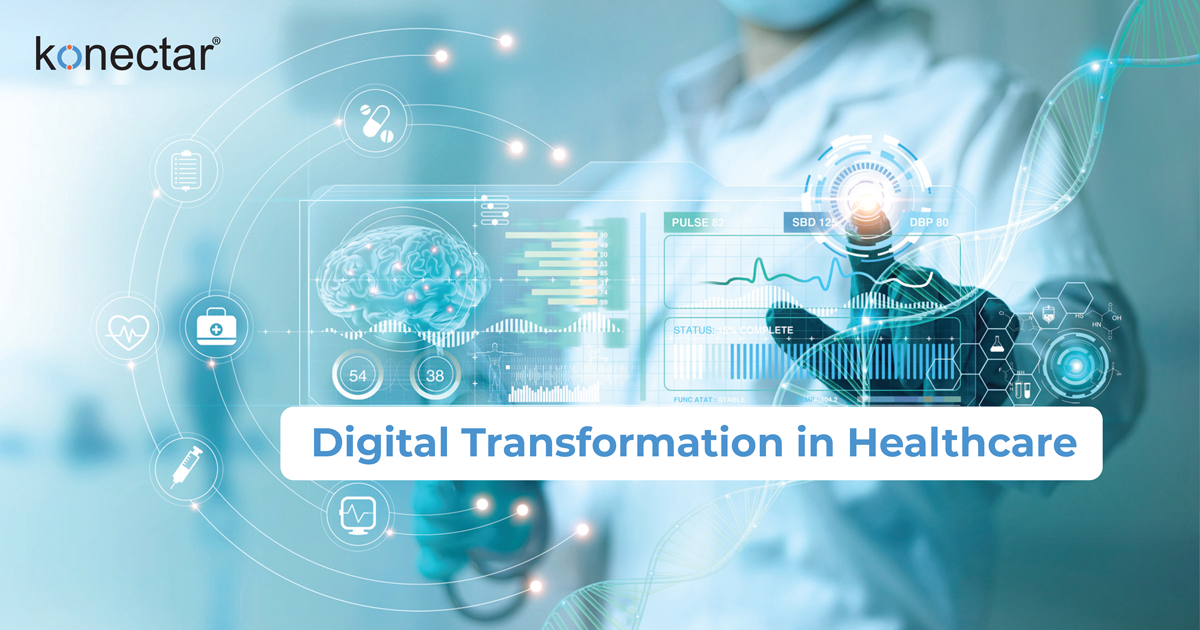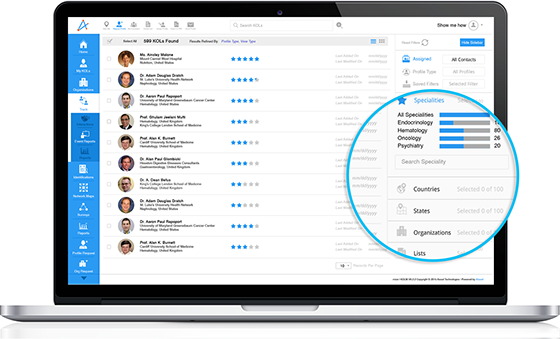16 Nov 2023
Digital Transformation in Healthcare

While digital transformation in healthcare had been steadily making inroads into the healthcare sector long before the COVID-19 pandemic, the events of 2020 served as a catalyst and propelled the pace of change to unprecedented levels. Digital Technology and tools have ushered in a wave of profound changes in the healthcare landscape. The transformation has also been driven by an empowered consumer base, who started taking greater ownership of their well-being.
In this article:
Charting the Growth
Digital transformation involves utilizing Technology and digital tools to enhance healthcare procedures, operational processes, and patient well-being. Healthcare has historically been a sector known for its reliance on traditional paper-based processes and siloed information systems. While this approach served its purpose, it was often marred by inefficiencies and limited patient engagement. However, the integration of digital tools has brought with it a sea of change, making healthcare more efficient, accessible, and patient-centric.
According to Future Market Insights, the market for digital transformation in healthcare is currently valued at $65.2 billion in 2023 and is projected to reach an estimated $253.6 billion by 2033! This robust valuation underscores the importance and widespread adoption of digital technologies within the healthcare industry.
Moreover, a study conducted by Deloitte reveals that Healthcare Organizations expect several benefits from integrating digital technology into their operations. These expected outcomes include enhancements in patient satisfaction, improved quality of care, increased competitive capability against traditional healthcare entities, revenue growth, greater cost-effectiveness, heightened agility, and enhanced operational efficiency.
Furthermore, the study identified the key functional areas where digital transformation efforts were directed. This included patient engagement, IT/digital/cyber, marketing, strategic planning, and financial management.
Technologies Driving Transformation
-
Telemedicine
Telemedicine, a form of digital healthcare, offers primary care for various medical conditions. It helps people with limited mobility, time limitations, or transportation difficulties to access healthcare conveniently from their homes. It also empowers patients to self-manage their healthcare with expert guidance.Telemedicine's remote capabilities have revolutionized healthcare delivery, bridging the gap for those who need quality care without the need for physical presence in healthcare organizations. Nevertheless, according to a study, the telemedicine market is projected to reach $113.1 billion by 2025!
-
Artificial Intelligence (AI) and Machine Learning
Artificial intelligence's demonstrated capacity for enhancing efficiency and even replacing human tasks is undeniable. It finds applications in various forms, with examples including chatbots, virtual health assistants, automating routine tasks, and furnishing data-driven insights for making informed decisions.
Chatbots, versatile in their roles, serve as customer service representatives, diagnostic aids, and therapeutic support. The global healthcare virtual assistant market is estimated to grow at a CAGR of 24.7%, reaching $1.76 billion by 2025. However, AI's most significant impact is observed in critical healthcare domains, such as precision medicine, medical imaging, drug discovery, and genomics.
-
Data Analytics
Big Data Analytics is transforming healthcare by identifying trends, improving decision-making, and optimizing resource allocation. By analyzing patient records, software can detect inconsistencies between a patient's health status and prescribed medications, promptly notifying healthcare providers and patients of potential medication errors to enhance patient safety.
Big data's predictive analytics can assist hospitals and clinics in forecasting future admission rates, enabling these facilities to allocate the appropriate staff resources to accommodate patient needs efficiently. This not only saves costs but also reduces emergency room waiting times during understaffed periods.
-
Connected Ambulance
Connected ambulances serve as invaluable healthcare assistants by collecting and transmitting critical patient data obtained through wearable devices, sensors, and HD cameras directly to the hospital. This proactive approach ensures that healthcare professionals have immediate access to essential information, allowing them to initiate necessary medical procedures without delay, even before the patient arrives at the hospital.
Benefits of Digital Transformation in Healthcare
The adoption of digital technologies in healthcare offers a multitude of benefits for both patients and healthcare providers.
-
Enhanced Patient Care
Digital transformation leads to improved Patient Care through faster and more precise diagnoses, better treatment plans, and personalized care.
-
Efficient Healthcare Operations
Efficiency gains are a hallmark of digital transformation. For instance, EHRs eliminate the need for paper records, streamlining administrative processes. Healthcare providers can access patient records securely and efficiently, leading to faster decision-making.
-
Reduced Healthcare Costs
While the initial investment in digital transformation may be significant, the long-term benefits often result in cost savings. Telemedicine and remote patient monitoring can reduce hospital readmissions and lower the cost of care.
-
Improved Patient Engagement
Patients have become more informed and are involved in their healthcare. They have access to their health data, can communicate with healthcare providers digitally, and monitor their health through wearable devices. This can lead to better adherence to medical treatments and healthier lifestyles.
Future Trends
The future of digital transformation in healthcare is poised to bring even more advancements. Here are a few trends to watch for:
-
Blockchain for Health Records
Implementing blockchain technology in EHR would provide Healthcare Professionals, including doctors and nurses, with centralized control over information flow. This would ensure everyone can access identical and instantly updated data within the entire network. Consequently, medical teams can place their trust in the accuracy and currency of patient information, leading to more reliable and effective patient care.
-
5G Connectivity
5G networks offer a remarkable advantage with an impressive 99.999% reliability. It provides guaranteed and widespread service coverage, essential for real-time 5G medical applications in healthcare, such as remote patient monitoring, Augmented Reality (AR-assisted robotic surgeries, and connected ambulances, where timely data transmission is critical.
Furthermore, 5G networks surpass their older wireless counterparts in terms of security, boasting advanced encryption protocols, enhanced privacy safeguards, software-defined infrastructure, and a sophisticated authentication framework. These security features make 5G a more trustworthy and secure choice for healthcare applications.
-
Virtual Reality (VR) and Augmented Reality (AR)
VR and AR technologies are revolutionizing medical training by offering cost-effective, high-quality learning experiences for healthcare professionals. These technologies enable hands-on skill development, improving precision and accuracy in procedures. But they will also find applications in body mapping, creating realistic simulations, and assisting with complex medical tests.
Beyond professional training, AR and VR can benefit patients by providing insights into their medical conditions and treatment possibilities. These technologies empower medical practitioners to visualize and understand patient data efficiently, help in precise disease diagnosis and risk assessment, and reduce the need for invasive procedures.
-
Predictive Analysis
Predictive Analysis will be crucial in guiding clinical management decisions. They will help tailor treatment to individual patient characteristics rather than relying on general population averages. Also, HCPs have recognized the critical importance of early intervention in managing progressive diseases and conditions with comorbidities.
However, the effectiveness of early intervention has often been hindered by the absence of tools that can handle extensive datasets and help provide more accurate insights. Predictive analytics in this context can be used to analyze extensive case histories of progressive diseases.
By enhancing the overall efficacy of treating prevalent chronic diseases, there is a potential domino effect of long-term benefits within healthcare organizations. This will ensure fewer patients progress to critical conditions. Thus, predictive Analysis will also provide personalized counseling to patients, contributing to more precise and patient-centric healthcare approaches.
FAQs
-
What is digital transformation in healthcare?
Digital transformation in healthcare involves integrating technology to enhance healthcare processes, improve patient care, and make the industry more efficient and patient-centric. It is essential as it leads to better patient outcomes, reduced costs, and improved accessibility to healthcare services.
-
Name some technologies driving digital transformation in healthcare?
Key technologies driving digital transformation in healthcare include telemedicine, artificial intelligence (AI) and machine learning, data analytics, connected ambulances, blockchain for health records, 5G connectivity, and virtual reality (VR) and augmented reality (AR). These technologies play an important role in improving healthcare services and patient care.
-
How does digital transformation benefit both healthcare providers and patients?
Digital transformation benefits healthcare providers by improving operational efficiency, reducing costs, and enhancing patient care. Patients benefit from faster and more accurate diagnoses, improved treatment plans, and increased engagement in their healthcare. It also makes healthcare more convenient and accessible.
-
What are the future trends in digital transformation in healthcare industry?
Future trends in digital healthcare transformation include the widespread use of blockchain for health records, the implementation of 5G connectivity for real-time medical applications, the use of VR and AR in medical training and patient education, and the application of predictive analytics for personalized Healthcare Management. These trends are expected to enhance the healthcare industry further.
Conclusion
Digital transformation in healthcare sector is a continuous journey that will change the course of healthcare from a reactive approach to a proactive one in managing health. This shift aims to provide higher-quality care and foster a more connected, digitally empowered healthcare experience for everyone involved.






